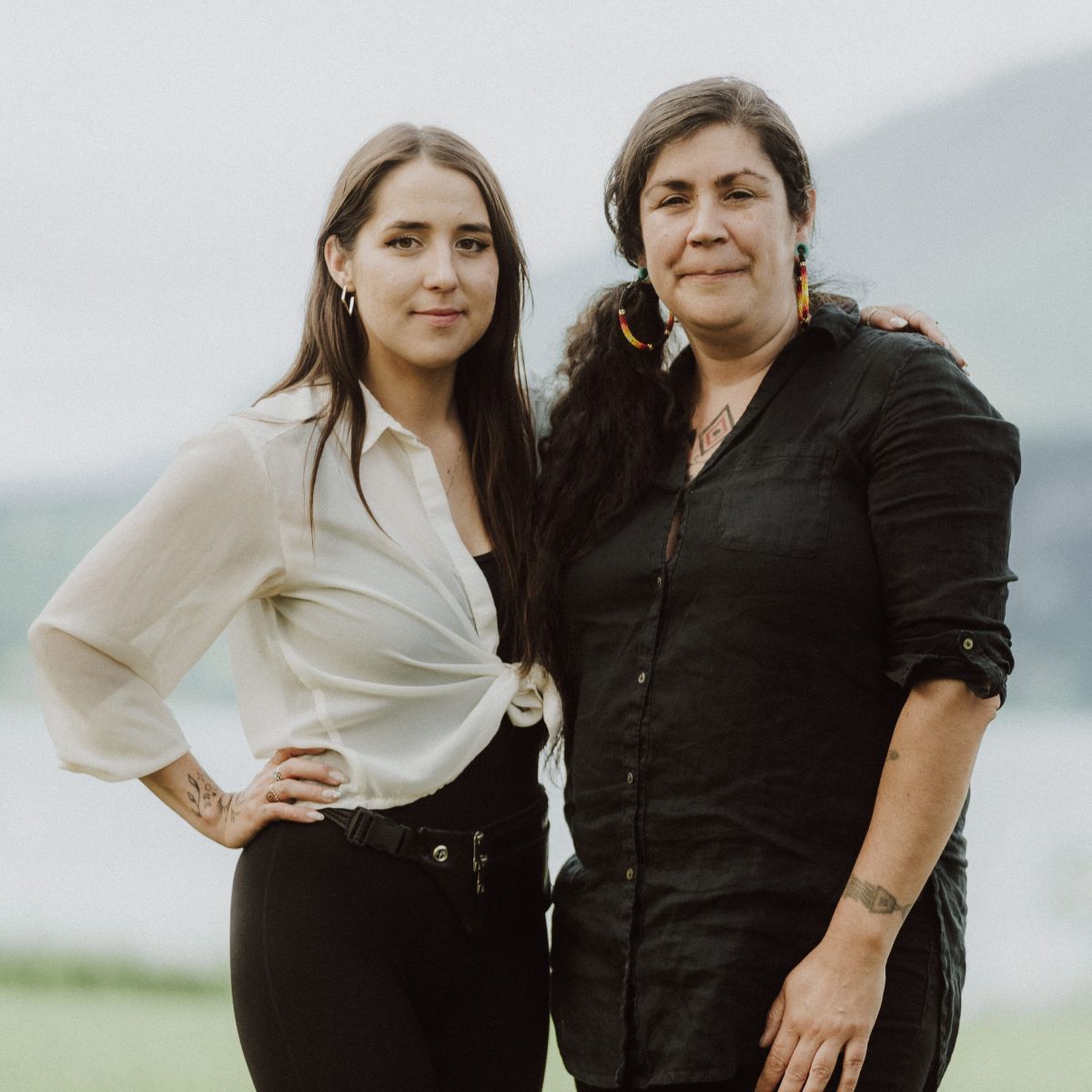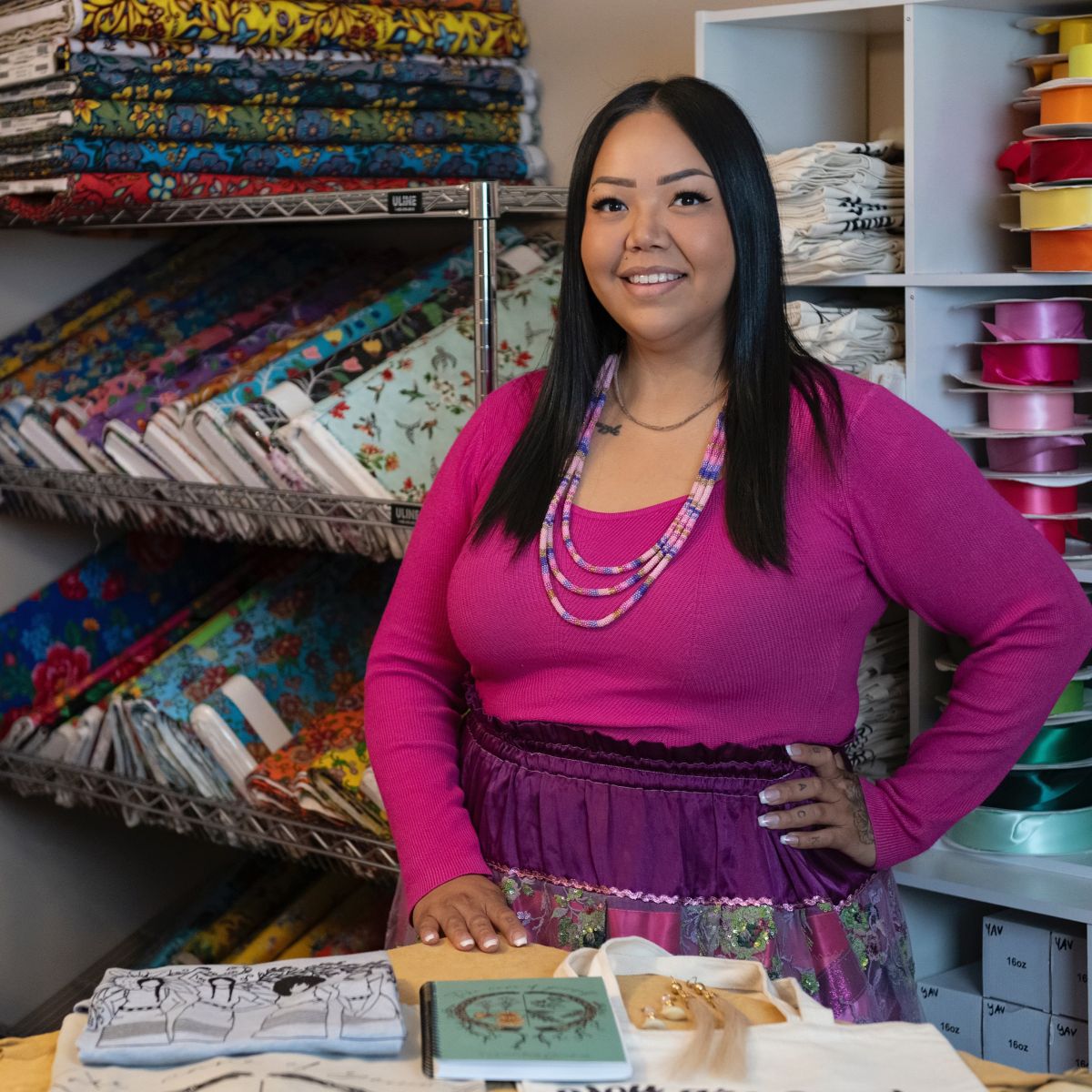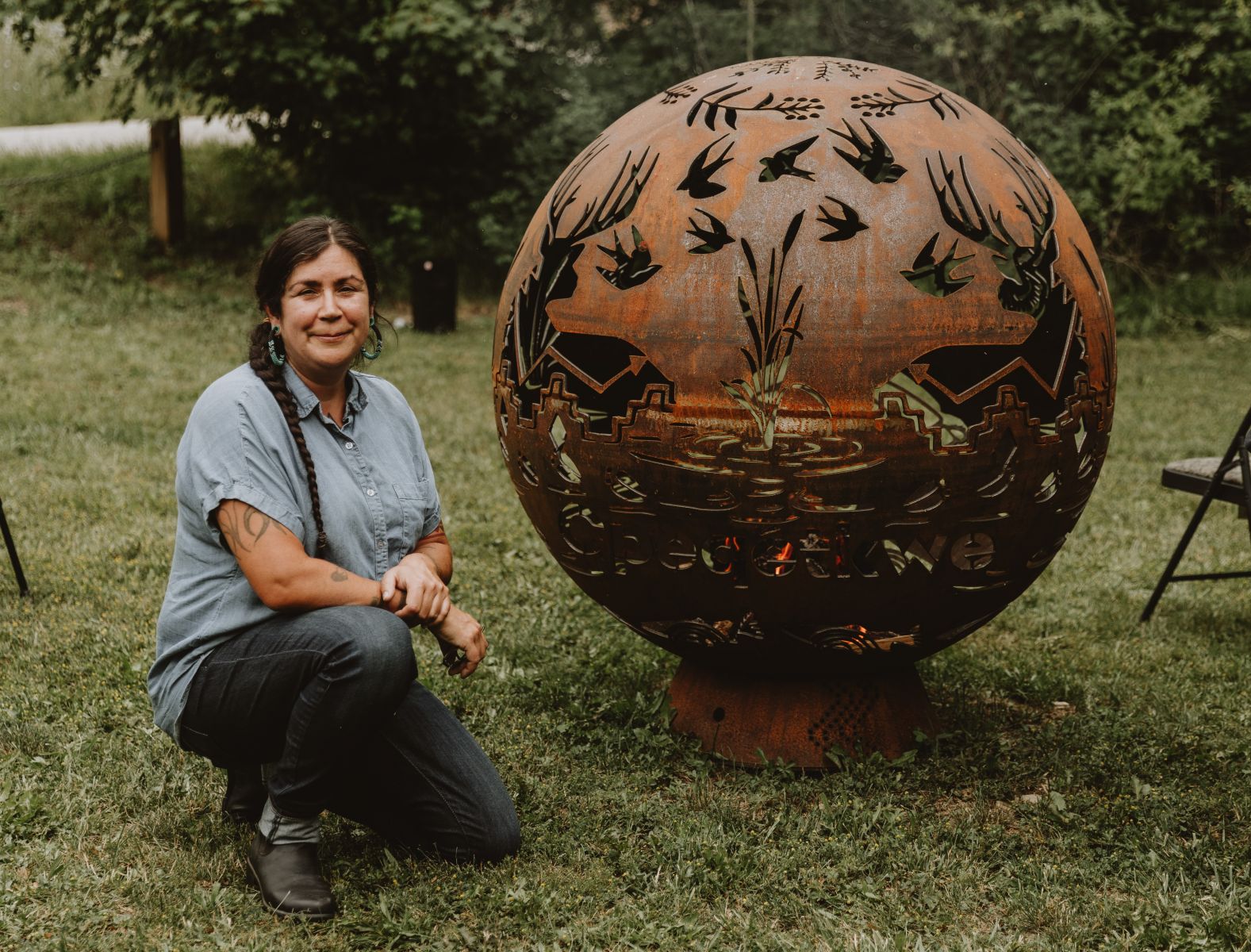Cpeqétkwe
White WaterVoiced by: Lucy William
View All Landmarks on Map
Cpeqétkwe Landmark Artists

Landmark Artists:
Tania Willard (Lead Artist, Secwépemc - Neskonlith)
Kel-c Jules (Supporting Artist, Secwépemc - Tk̓emlúps)
Photo by Billie Jean Gabriel

Interpretive Signage Illustrative Artist
Ashley Michel (Secwépemc - Tk̓emlúps)
Photo by Dennis Owen

Me7 plúlk' wete t'7élye ne seq'út.s r t7ikw: Gather here around the fire. Sculpture
Lead Artist: Tania Willard; Contributing Artist: Kel-C Jules
In making the artwork I listened carefully to Elders at the site visits and then reflected on my experience at each location. Celebrating our ongoing relations with the land I wanted the idea of having a fire; of being on our land and using it to make a statement. Design elements come from Secwépemc art and our interpretations of plants, animals and stories from each site. This work is designed for Secwepemc land use and to mark how we use our land. Secwepemcúl'ecw wel me7 yews wel me7 yews (Secwepemcúl'ecw forever and ever).
Interpretive Signage Illustration insert
Artist: Ashley Michel (Tk'emlúps te Secwépemc)
The illustrations I’ve created for the interpretive signage at these sacred Secwépemc places tell a story based on the traditional knowledge and lived experiences of our elders, intertwined in our history, with a modern twist.
About Cpeqétkwe
Cpeqétkwe ri7 r sts7emét.ste r pésellkwe t'e piq r séwllkwe.
R Cpeqétkwe t'e tmícw lu7 r Secwépemc r sentsxiyestés ne sqít'e t'e písell, ell ne spíxe t'e ts'i7,
teníye ell sesúq'w, ne tsquqúm. T'e slexlexéy'es lu7, r Secwépemc t'e sneri7s ne Cpeqétkwe t'e tmícw, le xqe7wéllenes e s7estúllns ell e sk'épems t'e scwet'mín' ne tsquqúm. Cwetúse7 lu7 nerí7 r tecwt'ícwell t'e speqpéq le7 t'ek stsíllen. Le q'7eses lu7 r Secwépemc tsyecwemínst.s r speqpéq t'síle t'e ckwen'llqtn e sle7s r sk'ult.s e pell stsíllens r mesmescen' ell r pell s7elk' wstsíllens r qelmúcw.
Le7 e sw7ecs r Secwépemc ne tmícw e syecwemíns r sk'wen'llq me7 lé7es r meláme, swewll ell mescén'. Xwexwéyt r stem t'e k'ult ell w7ec ne tmícw tsknucwetwécw m tselxestéses ell xqe7wen'ses xwexwéyt r stem pell s7elkst.
English Translation:
Cpeqétkwe means “white water” in Secwepemctsín, referring to a white sediment in White Lake.
Cpeqétkwe is a significant place where Secwépemc fish for trout and hunt deer, moose, and grouse in the surrounding mountains. Our memories of learning to skin and tan hides are anchored to the mountains around Cpeqétkwe. There is a diversity of berries here that have sustained our ancestors for generations. For many, many years, Secwépemc have cultivated their harvesting areas like gardens, using controlled burning and other cultivation practices to maintain and enhance berry patches and healthy habitats for significant animals.
Secwépemc presence on our land is vital for the health of our medicines, fish, and animals. Core Secwépemc values such as knucwetwécw (helping one another) are foundational to processes of teaching and learning on our land and recognizing that every living thing has a role.
Secwépemc Landmarks Project Background
The Secwépemc Landmarks Project is a Secwépemc-led arts project in the Shuswap Lakes region of Secwepemcúl'ecw, featuring a series of 15 Landmark sculptures carved by Secwépemc and non-Secwépemc contemporary artists. Each sculpture features Secwépemc oral histories and place names from the Secwépemc Lakes Elders Advisory Committee.
Secwépemc (“the spread-out people”), a Nation of 32 Interior Salishan communities that have been divided into 17 bands by the Indian Act, are 12,000 people strong and growing. Before contact with Europeans, the original population is estimated at 25,000 people, drastically reduced to 7,000 due to the 1862 smallpox epidemic. Secwépemc territory spans approximately 180,000 squared kilometres (112,000 squared miles) which includes the headwaters of the two largest river systems in British Columbia; the Columbia and Fraser River valleys, and extends south to the Arrow Lakes. Secwépemc have occupied their territory, Secwepemcúl̓ecw, for over 10,000 years and have never signed away, ceded or sold their land or territory.
.JPG)
Initial Project Concept, Tk'wemi'ple7 Shelley Witzky and Jacob Sutra Brett. Photo by Martha Wickett, Salmon Arm Observer.

Secwépemc Landmarks Elders Advisory Committee
Acknowledgements
The Secwépemc Landmarks project is led by Adams Lake Band, Neskonlith Band, Skwlāx te Secwepemcúl̓ecw, and Splatsín, with administrative support from the Shuswap Trail Alliance. The Secwépemc Landmarks Project Team would like to acknowledge with heartfelt gratitude the many community members and sponsors who have made this project possible.
The Secwepemctsín place name audio recordings are by Lucy William, Donna Antoine, and the late Neskonlith Elder Dr. Mary Thomas, whose work as a knowledge keeper and environmentalist inspired many about Secwépemc values of knucwentwécw (helping one another) to learn about and protect Secwépemc traditional plants for future generations. Secwepemctsín language revisions for the place names transcriptions and signage were completed by the Cstélnec Elders at Chief Atahm School and Donna Antoine (Splatsín dialect).
The Secwépemc Lakes Elders Advisory Committee, made up of Elders from Adams Lake Band, Neskonlith Band, Splatsín, and Little Shuswap Lake Band, guided this project. Each Landmark sculpture represents oral histories connected to each place. The Project Team would like to acknowledge the contributions and guidance of all Elders attending the Secwépemc Lakes Advisory Committee meetings.
The Project Team is made up of Shelley Witzky-Spemulecw (Project Manager), Libby Chisholm (Project Coordinator), Dorry William (Elders Coordinator), Ash Simpson (Splatsin Title and Rights), and previous contributors include Micky Tomma (Research Assistant), and Qwelmínte Secwépemc interns Devin Doss and Mackenzie Creasser. Landmark Artists include Tania Willard, Kel-c Jules, Rod Tomma, Tilkotmes Tomma, the late Mike Peters, Eric Kutschker, David Jacob Harder, Shayne Hunt, Hop You, Tony Antoine, Vern Clemah, Jules Arnouse, Rick, and Kenthen Thomas (storyteller).
The Secwépemc Landmarks project is funded in part by Adams Lake Band, Neskonlith Band, Little Shuswap Lake Band, Splatsín, the Shuswap Trail Alliance, the Province of British Columbia, Shuswap Tourism, the City of Salmon Arm, SASCU, Hard Rock Granite, Heritage BC through the Heritage Legacy Fund, as well as through in-kind donors such as AIM Roads, the Salmon Arm Arts Centre, School District No. 83, Switzmalph Cultural Society, Len Lega, and Browne Johnson Land Surveyors. Kukstsémc also to staff and students from Shihiya, Chief Atahm, Jackson, Sullivan, SMS, and South Canoe schools for their work on the Secwépemc Landmarks trailhead posts.
Exploring Respectfully
Shuswap Trails
Fostering a healthy, engaged community in the Shuswap Region – economic/environmental/social – through well designed, maintained, and promoted trails connecting people, culture, and landscape

